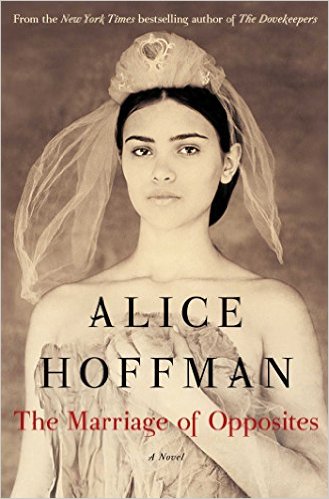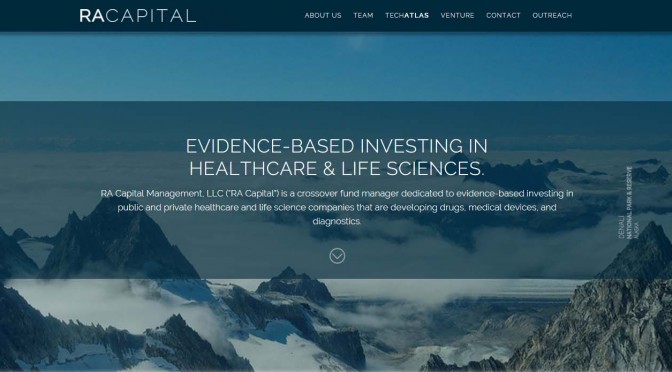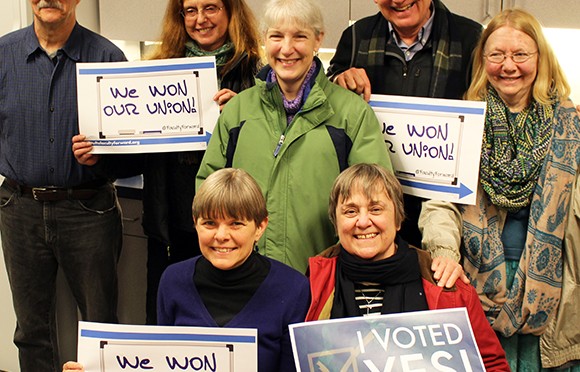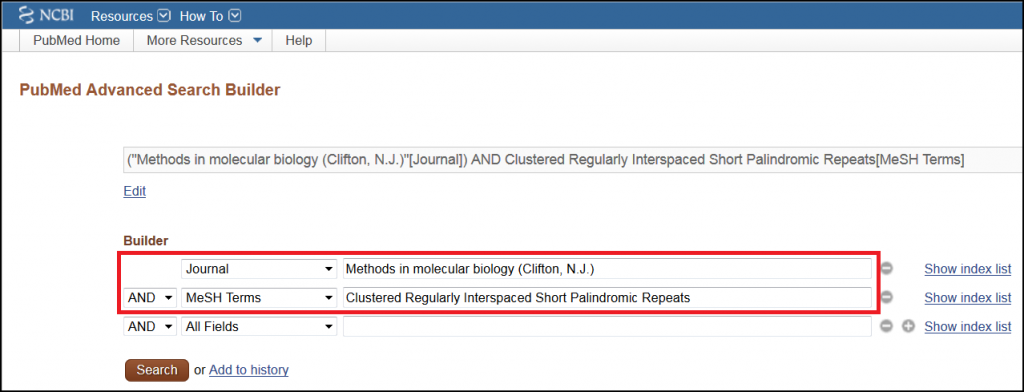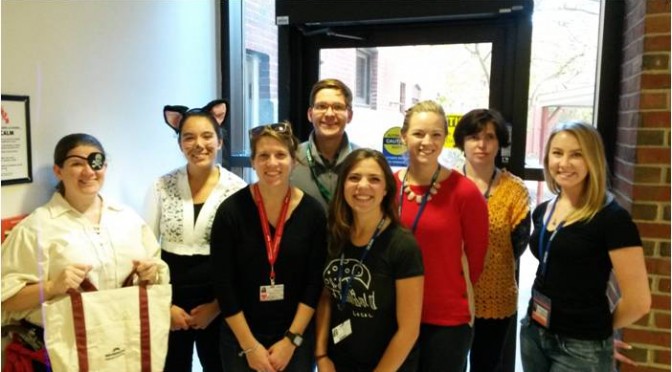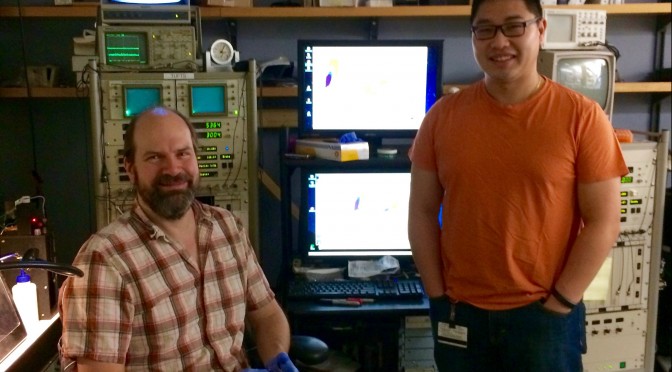Category Archives: February 2016
On the Shelf…
For work…
Electronic Resource: Henry Stewart Talks – Biomedical & Life Sciences Collection
Location: Search for ‘Henry Stewart Talks’ in Databases search box on the HHSL homepage (http://hirshlibrary.tufts.edu/)
Video collection of seminar style lectures by leading scientists on the fundamentals and latest research in a variety of areas, including: cancer, cell biology, immunology and pharmacology. Separate subject area devoted to methods.
And leisure…
The Marriage of Opposites, by Alice Hoffman
Location: HHSL Leisure Reading, Sackler, 4th Floor (http://library.tufts.edu:80/record=b2798246~S1)
Novel based on the life of Rachel Pissarro, mother of the Impressionist painter Camille Pissarro.
Contributing to the Healthcare Ecosystem through Evidence-based Investing
In an effort to continually explore the interface between science and business, Tufts Biomedical Business Club recently caught up with Dr. Zach Scheiner, an Associate at RA Capital Management, for a discussion about his experience in the healthcare investment industry.
RA Capital Management is a crossover fund manager dedicated to evidence-based investing in public and private healthcare and life science companies. Prior to his current role at RA Capital, Zach worked as a Science Officer at the California Institute for Regenerative Medicine, where he managed a portfolio of research programs concentrated in translational neuroscience. He holds a BS in Molecular Biophysics and Biochemistry from Yale University, and a PhD in Neurobiology and Behavior from the University of Washington.
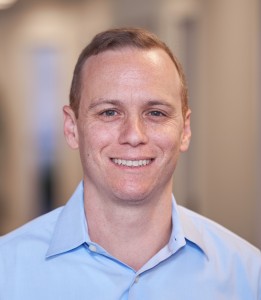
As an Associate for RA Capital, Zach’s efforts are realized through the team’s core research division, TechAtlas. This division is a scientifically trained team that maps out competitive landscapes in a continual effort to survey the landscape and identify emerging therapeutics and technologies that will reshape how physicians treat disease. The interview is edited for brevity and clarity.
Tell me about the career path that led you to your job. How did you become involved with RA Capital Management?
My interest in biomedical science and research began as an undergrad, when I had several summer research internships and was exposed to a few different fields of research. At the same time I had my first opportunity to teach science classes at a local high school and quickly realized that I also had a passion for teaching. After graduating, I decided to teach middle school science and math for a year (which turned into three) before returning to research and going to grad school.
I attended the Neurobiology & Behavior graduate program at The University of Washington in Seattle. My thesis work focused on the molecular basis of memory and drug addiction. Though I enjoyed my time as a graduate student, by my fourth year I began to realize that the academic career path and spending more years at the lab bench were not for me. I really enjoyed reading primary literature, planning experiments, and reviewing/analyzing data, so as I finished up graduate school I began looking at alternatives where I might be able to incorporate these interests as well as leverage my scientific background in a non-research capacity.
I found a great opportunity at the California Institute for Regenerative Medicine (CIRM) in San Francisco. CIRM funds stem cell research at institutions throughout California with the goal of advancing promising stem cell based therapies into clinical trials and ultimately to patients. I began as a science writer and quickly moved to a position managing a portfolio of translational research programs. In this position, I worked closely with funded scientists to help set milestones and success criteria, assess progress, and, however possible, facilitate success. In my six years at CIRM I learned a tremendous amount about the drug development process, gained experience reviewing and analyzing data, and developed management skills, all of which have been invaluable in my current role at RA Capital.
My move to RA Capital was the result of my wife being offered an assistant professorship at Brown University. In preparation for the move from one coast to the other I reached out to everyone in my network, including an old lab-mate I had stayed in touch with from graduate school who was now an Associate for RA Capital. I had a long-time interest in biotech investing, nurtured by my dad, and had been learning about this part of the industry in my spare time. Luckily, RA was hiring and the rest is history. For me, RA Capital was a perfect fit. I can put my communication and analytical skills from teaching, grad school and CIRM to good use and I love staying immersed in cutting-edge science while learning more about the investment side of the biotech industry.
What are the duties/functions/responsibilities of your job?
As an Associate with RA Capital, my primary role involves creating dendrograms (mind-maps) of specific diseases or capabilities within the healthcare industry. These comprehensive landscape maps take all the available drugs, both on the market and still in development, and put them into the context of current standard of care and unmet needs. They help our team fully appreciate and contextualize the market potential of assets and companies before making investments. Mapping out a disease landscape is a research-intensive process that involves surveying the literature, meeting with companies with assets in the space, speaking directly to physicians, attending scientific conferences, and analyzing data. The process can take several months to complete but the maps are never truly finished. Therapeutic landscapes are constantly evolving, new data are released and new licensing and acquisition deals are made. Our maps are equally dynamic and a lot of my time is spent staying up to date with the latest news and data coming out in the areas I cover.
In addition to mapping, Associates also join the investment team in diligence projects on specific investment opportunities. Our maps are a great way of contextualizing drugs and their competitors and can help our team identify potential new opportunities but it’s always critical to dig deeper before making an investment. One of the most rewarding parts of my job is seeing all the work I’ve put in researching and understanding a therapeutic space pay off with insights that are potentially investable, or that directly benefit a diligence project.
On a day-to-day basis I also survey industry news and the scientific literature not only to keep up with the science but to search for new investment opportunities that could be licensable for an RA Capital portfolio company or even form the basis for a new company. I also enjoy being involved in the recruiting process at RA and playing a small role in shaping the future of the company.
What is the most rewarding part about your job?
Personally, the most rewarding part of my work is knowing that we are investing in companies that are developing therapies for patients that really need them! These companies often have no marketed drugs and need capital to advance their assets through clinical trials and into the hands of patients. When I think about the work that I do, I know I am helping to identify great science, underappreciated drugs, and promising new opportunities. And I hope that by influencing where RA Capital’s dollars are invested, I’m impacting the whole healthcare ecosystem in a positive way.
What experiences best prepared you for your job?
I think all of my previous work experiences helped prepare me for RA Capital, the first of which was teaching. Communication is such an essential skill and getting an opportunity to develop this early in my career has been a huge benefit. Having controlled a classroom every day for three years definitely makes communicating with colleagues, companies and scientific experts a little easier. Effective communication is a vital part of this job.
The second experience is my time spent as a graduate student. In graduate school I learned how to rigorously analyze data, both my own and from the literature. I developed my critical thinking and analytical skills and the ability to quickly identify key questions, design key experiments, and understand the limitations of a study.
Lastly, at CIRM I learned the process of moving a drug from the lab to the market and everything in between. I also regularly participated in grant review meetings with panels of scientists, clinicians, and patient advocates. These meetings gave me the opportunity to learn what was truly important to each group. While the views and opinions would often vary between the groups, one key takeaway was that for a drug to succeed, doctors have to want to prescribe it and patients have to want to use it. My experience at CIRM taught me to evaluate drugs with the patient perspective in mind; new therapies are worthless unless patients will use them, and sometimes improvements that appear marginal can be very meaningful to patients.
What skills or personal characteristics do you feel contribute most to success in this industry?
Very often, investment firms require that applicants have a background in finance, an MBA, or prior experience in the industry. That is not the case at RA Capital. I wouldn’t say any particular background or degree is required, but there are certainly skills that are critical. Analytical skills, for example. The ability to rigorously analyze data and quickly get to the “meat” of primary literature or a clinical data set is invaluable. Another key skill is effective writing and communication. Much of my day is spent writing and talking. I am continuously expressing my thoughts and providing analysis and it is important to do so concisely and effectively.
In terms of personal characteristics, I would highlight skepticism. Being skeptical is a common trait among scientists due to the nature of research, but this skill is especially important when meeting with companies. Every company is trying to convince us that their assets or data are the best. Skepticism is required to separate the pitch from the quality of the science.
Humility is another important personal characteristic. To put it simply, in something as complicated as drug development, it’s easy to be wrong! There are so many variables to consider, and science changes so quickly; it’s essential to have an open mind and be humble about everything you do not know.
What are the biggest challenges you face as an associate for RA Capital Management?
I think the largest challenge I face is simply the pace of the industry and science itself. There is new data coming out all the time; from company press releases, new primary literature, scientific conferences—the amount of information can be overwhelming. Developing the ability to quickly assimilate and analyze new information is the biggest challenge. But it’s also one of the things I enjoy most about my job. In this field you have to enjoy constant learning and also get good at processing information quickly enough to inform an investment decision. The fast pace is challenging but exciting.
What are some other opportunities within RA Capital Management for scientists aside from the TechAtlas Research Division?
Most opportunities for PhD trained scientists are within our TechAtlas research team. This team is made up primarily of PhD trained scientists in either Associate or Scientific Writer positions. The Science Writers work closely with the Associates as they build the story of their map, acting as a thought partner to develop the key insights for standard of care, unmet needs, and investable opportunities for each disease. As members of the research team gain experience, they can specialize in one of several areas, including early-stage assets, strategic analysis of licensing and partnerships, and equity analysis.
For somebody interested in pursuing this career, what would be your advice to best prepare them?
I would highly recommend that PhD candidates supplement their education in three areas: biostatistics, clinical trials, and FDA regulatory pathways. These topics are not always emphasized or even addressed in many graduate programs. A working knowledge of biostatistics goes a long way; being able to understand statistical pitfalls and the pros and cons of different analyses is invaluable. I would also recommend becoming familiar with clinical trials: the general FDA requirements for advancing drugs into Phase 1 trials and the typical development path for new therapies in your field of interest. Few graduate students get exposed to these areas. I would strongly suggest looking beyond the specific questions of own research project to get an understanding of the broader context: the standard of care for the disease, unmet needs, and competing approaches. If your research isn’t disease or therapy focused, choose a disease of interest or imagine potential applications of your work and research those. Putting new research and data into a broad context is a lot of what we do, so the earlier you can start practicing, the better prepared you will be.
Upcoming TBBC Events
The Tufts Biomedical Business Club (TBBC) is a student run organization whose mission is to cultivate business leaders in the health and life sciences. TBBC is a growing community of graduate, medical, dental and nutrition students, postdocs, physicians, scientists and alumni. It provides members with opportunities to learn about consulting, business development, entrepreneurship, intellectual property and more. We engage our members though a number of initiatives including a seminar series, Biotech Journal Club, Consulting Case Study Group, panel discussions, and most recently Biotech BUZZ. E-mail tuftsbiotech@gmail.com for more information
Upcoming events:
TBBC Case Study Group
Mondays – 5-7PM, Jaharis 508
Julie Hewitt Coleman guides students and postdocs through the case interview process. Practice solving cases, gain insight and tips, and learn more about the field of consulting.
TBBC Dr. Dave Greenwald
Tu Feb 9 – 5-6:30PM, Sackler 114E
Dr. Dave Greenwald, a 2010 Sackler alum, now Director of Business Development and Corporate Sponsorships at Johns Hopkins Technology Ventures, will give a career seminar titled, “Starting a Company: Practical Advice for a Precarious Pursuit.”
TBBC Dr. Lauren Linton
Th Feb 25 – 5-6:30PM, Sackler 316
Dr. Lauren Linton, Deputy Director of the Tufts Institute for Innovation, formerly co-Director of the Sequencing Center at the Whitehead Institute and Associate Director of the Center for Genome Research at the Whitehead/MIT, will give a career seminar titled, “Don’t Be Afraid to Experiment.”
TBBC Biotech Journal Club
F Feb 26 — 12PM Noon, Jaharis 155
BJC will meet to discuss current topics in the biotech industry. To join the mailing list, email tuftsbiotech@gmail.com with the subject line: BJC
Recent Events:
TBBC Biotech Journal Club
F Jan 29: Townsend Benard gave a presentation on the Innovative Medicines Initiative, Europe’s largest public-private effort aimed at speeding the development of better and safer medicines for patients.
TBBC Sackler Speaks
Th Feb 4: TBBC partnered with the Graduate Student Council to host a flash talk competition among Tufts students. Eleven speakers gave 3-minute presentations on their research; Jess Davis-Knowlton took home first prize.
TUSM Faculty takes steps to unionize
On December 11, 2014, tenured and tenure-track faculty members of the Tufts University School of Medicine (TUSM) filed a petition to the National Labor Relations Board (NLRB) to hold on-campus union elections. If this election is allowed by NLRB, then the 70 members of the TUSM faculty will join the ranks of their Medford colleagues in the Faculty Forward union at Tufts, a division of the Service Employees’ International Union (SEIU) Local 509 (1). As mentioned, this is not the first time Tufts-affiliated faculty have filed for unionizing. In February 2015, majority of the Medford/Somerville campus faculty had voted in favor of unionizing in an effort to improve working conditions (2). And even before that in 2014, adjunct faculty members on the Medford campus, rallying under the Adjunct Action division of SEIU, negotiated a significant raise in their pay (3) that is set to be completely in effect by September 2016 (4).

The TUSM faculty appears to be motivated for similar reasons; in a joint email to Tufts Daily, Dr. Karina Meiri, Professor of Developmental, Chemical & Molecular Biology (DMCB), and Dr. Henry Wortis, Professor of Integrated Physiology & Pathobiology (IPP), mentioned issues regarding salary and research funding as major sources of motivation. They elaborated in the letter that while faculty members are trying to get funding in an increasingly competitive environment with diminishing sources, the university is putting on additional pressure on them by providing “negative incentives”. Drs. Meiri and Wortis mentioned, “If faculty were unsuccessful, [in their application] as they were pretty much bound to be, given the odds, their salaries would immediately be cut, often by very significant amounts.” They also pointed out that many faculty felt that their ability to speak their minds on administrative decisions was being limited. Drs. Meiri and Wortis believe that through unionization, financial transparency and partial restoration of decision-making ability, job security and stability can be achieved for the faculty. To quote, “Our strong belief is that the educators and researchers at a university need to be deeply involved in decisions that shape its mission and that unionization will provide a path towards…the return of collegiality”. It seems that majority of the TUSM faculty are in favor of unionizing, as almost 60% of them had voted in favor of holding on-campus elections. The ones who did not vote, either did not do so because they do not want a union or they do not feel strongly enough for the need of one, as Drs. Meiri & Wortis explained in their letter.
Faculty unions are not new in this part of the country – if the TUSM faculty are allowed to hold elections on campus, they will join their colleagues at Northeastern, BU, Lesley and Bentley Universities (5). There is also an increasing trend of faculty unionization throughout the country, and Drs. Meiri & Wortis believe it to be a reactionary movement to the increasing adaption of a for-profit model by universities. They explained in their letter, “Many universities have chosen to save money by shifting the burden of teaching to part-time untenured…adjunct faculty members. Others have increased the cost of enrollment to plug financial holes. University priorities are increasingly being set by financial rather than academic agenda. Across the country whenever universities are being managed as corporations rather than collegial institutions faculty are increasingly looking towards unionization as a means to re-assert the original model of shared decision-making.”
While it may seem reasonable to allow tenured and tenure-track faculty to unionize, it is not the case. The legal precedent set by the 1980 ruling in the NLRB v. Yeshiva University, which found the tenured faculty not eligible for unionization for their significant influence on administrative decisions, stacks the odds against the TUSM faculty’s hopes of holding on-campus elections. This precedent is also partially responsible for the opposition of the TUSM administration to the faculty’s petition at the NLRB. As the Executive Director of Public Relations, Kim Thurler, told Tufts Daily “that 1980 Supreme Court ruling … recognizes the substantial authority faculty members hold and their significant voice in determining curriculum, academic standards and policies. Many NLRB decisions since 1980 have followed this Supreme Court precedent.” (1)
Currently, the TUSM faculty waits on the NLRB’s decision on whether they will be allowed to hold elections or not. Regardless of this decision, the fact that this has become a trend across universities, institutions founded on principles of non-profit due to their increasing profiteering nature, is a great cause of concern indeed.
Drs. Meiri & Wortis’ quotes have been reproduced from their letter to Tufts Daily with their permission. The Tufts Daily article was published on Jan 29, 2016, and can be found here.
Qualifying Exam Survival Toolkit: Faith, Trust, & Post-Its
I read my drafted email with the attached qualifying exam proposal for the fifteenth time, hit send, and then I felt like I was going to throw up.
It was March, the snow outside was half-melted and tinged gray with grime, and I had just submitted my qualifying exam proposal. Three weeks of carrying highlighters in my pockets, drinking tea morning to night, and rarely parting from my computer, and it all came down to the click of a button. At the time, it felt like the most deciding thing I would ever do during my PhD, and that was terrifying. Looking back, it was probably just the irregular sleep hours and too much takeout that had me feeling slightly nauseous.
So, my advice, first and foremost: buy a lot of groceries and do your laundry ahead of time. I sound like a parent, I know, but still: do it. Good food and clean clothes–as well as having those tasks checked off your list in advance–really can save you in the midst of spirals of self-doubt or experimental design frustration. And you will have those moments, but it is important to know they will either pass eventually, or you will beat it by finding a way to prove yourself wrong.
Everyone–and I do mean everyone–told me, with fond amusement: you’ll be fine, it won’t be that bad, no one is out to get you. And I can tell you, with complete certainty, that is true in retrospect. I have become the older student whom I regarded with respectful but extreme skepticism this time last year. Like they said, I ended up being just fine. Still, I remember the stress and the worry, the cycle of figuring out a problem in my proposal to only have that create yet another problem, and so it went, on and on. So I will avoid telling you what most others will and instead advise this: trust your knowledge and your intuition, even if you try to convince yourself otherwise, because you do know what you are talking about. Have faith. You are going to be your own worst enemy in this four weeks of research and writing, planning and designing, but at least it is an enemy you know well. Use that to your benefit: trust your doubt, because it will help you find holes in your work where others will as well.
And there will be holes; you can’t catch them all. This is where help from older students comes in. Your practice talk with them will be one of the most valuable experiences in this process. Be prepared for your 10-15 minute talk to take an hour, or probably two, to be critiqued by your peers. You may not be able to answer all of their questions, but those are questions you then will be able to answer in your exam if they get asked. Their advice on layout and presenting style is also invaluable; they have gone through this before, and their experiences and mistakes in their own exams will be your gain. Take full advantage, even if you have to bribe them to attend with baked goods (just kidding!).
Lastly, invest in some post-its. Keep them everywhere–by your desk, by your bed, in your bag. When an idea or a question or a worry strikes, you’ll have somewhere to record it, especially if you don’t have time to deal with it at that moment.
Faith. Trust. Post-its.
Good luck!
Notes from the Library…Finding Protocols & Methods
 In December, I mentioned Journal of Visualized Experiments (JoVE), a journal that publishes experimental techniques in video format. In addition to JoVE, there are several resources for techniques, protocols and methods:
In December, I mentioned Journal of Visualized Experiments (JoVE), a journal that publishes experimental techniques in video format. In addition to JoVE, there are several resources for techniques, protocols and methods:
- Bio-Protocol: Open-access, peer-reviewed e-journal established by a group of Stanford researchers. Publishes detailed biomedical protocols for cancer biology, immunology, molecular biology, neuroscience and more. Freely available at: http://www.bio-protocol.org/.
- Cold Spring Harbor Protocols: Publishes both well-established and cutting-edge research methods in cell, developmental and molecular biology, genetics, protein science, immunology, etc. Available online through Tufts Libraries: https://library.tufts.edu:443/record=b2164037~S1.
- Current Protocols: Peer-reviewed, regularly updated laboratory protocols for cell biology, human genetics, immunology, molecular biology, etc. Available online through Tufts Libraries: http://www.library.tufts.edu/ezproxy/ezproxy.asp?LOCATION=WBCurPro.
- Journal of Visualized Experiments (JoVE): Available online through Tufts Libraries: https://library.tufts.edu:443/record=b2178505~S10
- Methods: Journal that focuses on developing techniques in the biomedical sciences. Each topical issue is comprised of invited articles by specialist authors. Available online through Tufts Libraries: https://library.tufts.edu:443/record=b2180868~S10.
- Nature Methods: Publishes novel methods, and significant improvements to established techniques, in life sciences and chemistry research. Available online through Tufts Libraries: https://library.tufts.edu:443/record=b1694504~S10.
- Nature Protocols: Publishes laboratory protocols, providing step-by-step descriptions of procedures. Available online through Tufts Libraries: https://library.tufts.edu:443/record=b2182128~S10.
- Protocol Exchange: Open repository for the deposition and sharing of protocols, from Nature Protocols. Protocols are not peer-reviewed or edited, but free to use or comment upon. Freely available at: http://www.nature.com/protocolexchange/.
- Springer Protocols: Collection of step-by-step protocols and methods published in the Methods in… book series and other laboratory handbooks. Available online through Tufts Libraries: https://www.library.tufts.edu/ezproxy/ezproxy.asp?LOCATION=http://www.springerlink.com/protocols/.
PubMed Tip of the Month: Searching for Methods
There are several techniques that can help you find methodology articles in PubMed:
- MeSH Headings for Methodology: “Methods” and “Research Design” are MeSH headings. You can try combining these terms with MeSH headings or keywords for your topic.
- MeSH Headings for Particular Technique(s): Depending on your area of research, there may be a specific MeSH term for the category of techniques in which you are interested, e.g. “Cell Culture Techniques”.
- Subheadings: Subheadings are used in conjunction with MeSH terms to further describe a particular aspect of that term. Subheadings follow a MeSH term, e.g. “Polymerase Chain Reaction/methods”[MeSH]. Subheadings can also be free-floated in a search, e.g. “DNA Replication”[MeSH] AND “Methods”[Subheading]. Two useful subheadings for methodology searches are “Isolation and Purification” and “Methods” (yes, Methods is both a heading and subheading).
- Search Particular Journal(s): You may wish to narrow your search to one or more journals devoted to methodology. To do so, open the Advanced Search Builder by clicking the Advanced link below the PubMed search box. Select Journal from the dropdown menu and start typing the title of the journal in the adjacent search box. Choose the journal from the list of titles that appear. Enter a search term in the next search box to search the journal for articles on a specific topic, e.g. “Methods in molecular biology”[Journal] AND CRISPR.
Notes from the North – Northern Networking
Teleconferencing from 100 miles away into classes, meetings, and extracurricular events is all well and good, but sometimes you just feel the need to practice schmoozing in person. The Sackler Graduate Student Council holds really relevant and useful networking events, and much of the content of these events can be taken advantage of through a teleconference connection, but it is hard to beat the rapport that is established when chatting, or bemoaning, face to face with colleagues over hors d’oeuvres. For anyone who does the bulk of their work away from the main campus of their organization it is imperative to find and cultivate local career enhancement resources. Not only does this give you access to opportunities in your local sphere, it also improves your connection with the members of the satellite facility.
For Sackler students studying at the Maine Medical Center Research Institute (MMCRI) in Scarborough, ME this resource is available in the form of the MMCRI Research Fellows Association (RFA). Because MMCRI is a relatively small institute, we currently have about twenty principal investigators, we have a fairly small number of postdoctoral fellows and even fewer graduate students at any given time. The RFA was originally founded to serve both groups and has recently expanded to serve non-faculty scientific staff and technicians as well. These groups share many of the same needs in terms of networking and professional development events, so the inclusiveness of the organization has worked well for us thus far.
The RFA leadership team and active members are constantly kept busy to ensure we are providing meaningful events each month. Here’s just a small taste of what we do:
• Increase MMCRI visibility in the community by sending members to participate in local career fairs and the Maine Science Festival
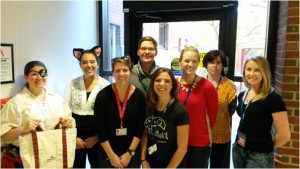
• Organize scientific talks from speakers suggested and voted on by RFA members
• Hold professional development workshops such as “Intro to LinkedIn” and “The Art of Schmoozing” lead by University of New England’s Career Services Coordinator, Jeff Nevers
• Maintain a library of material on resume writing, cover letter writing, grant writing, and networking advice
• Work closely with MMCRI and MMC Human Resources to utilize hospital resources such as MMC’s Training and Organizational Development department for the benefit of our members
• Poll members annually on which of their professional development needs are being met and which still need to be filled
One of our newest events is also one of my favorites. In the spirit of positive reinforcement we recognize and celebrate either a mentor or a pair of researchers (one technician and one academic) of the year. This occasion allows the RFA to show appreciation for mentors and colleagues who demonstrate superlative qualities. Appreciation in the case of researchers includes $500 from the RFA discretionary fund (supported by our fundraising efforts) to participate in further career enhancement.

MMCRI may be 100 miles away from the biotech hub that is Boston, but we’re no backwater slouches when it comes to career enhancement and professional development!
Techniques – Go with the Flow
What is Flow Cytometry and what can it do for you?
by Stephen Kwok & Allen Parmelee
Flow Cytometry is something I never heard about in school, but once I learned about it, the possibilities seemed endless as to how I could use it as a tool to make work and research better. FACS (Fluorescence Activated Cell Sorting) Sounds like an office tool, not a state of the art piece of scientific equipment. In reality, it is like a multitude of fluorescent microscopes all working together to gather data at the same time. Wait, it gets better…you can actually physically separate your cells from one single cell per well on a 96 well plate, to millions of cells in a 15ml tube! The human eye has a habit to have bias; these machines convert the analog data into a digital plot or histogram that can’t be argued with! Is it 30% positive or 35% positive? Yes, we can actually tell the difference!
Let’s back up a step here. The technology is best used if you have markers for your cells. You can take fluorescently labeled antiboties to identify cells. Let’s say you are looking for stem cells. Cd34, SCA-1, and c-Kit are common for hematopoietic stem cells. Label these three, throw in a viability marker, and you have successfully identified these cells. You can move forward with your experiment and simply ANALYZE the cells. Or, you can try to isolate these cells by SORTING them. Fluorescent protein transfections with a GFP or RFP marker are common. Why grow cells in harsh selection media when you can simply pluck them out and put them into a plate? I need to do some PCR, but I have to figure out how to get 1 cell, 5 cells, 25 cells, 50 cells. Limited dilution is going to take me forever! In as fast as 30 seconds you can have those exact numbers of cells lined up into your pcr tubes or a 96 well plate.
At our facility we have cell analyzers available for use 24/7. We train people in basic theory, and then help them get started on how to run the instruments. Sorting, however, is a little more complicated and is done by the two intimidating guys running the facility: Allen and Steve.
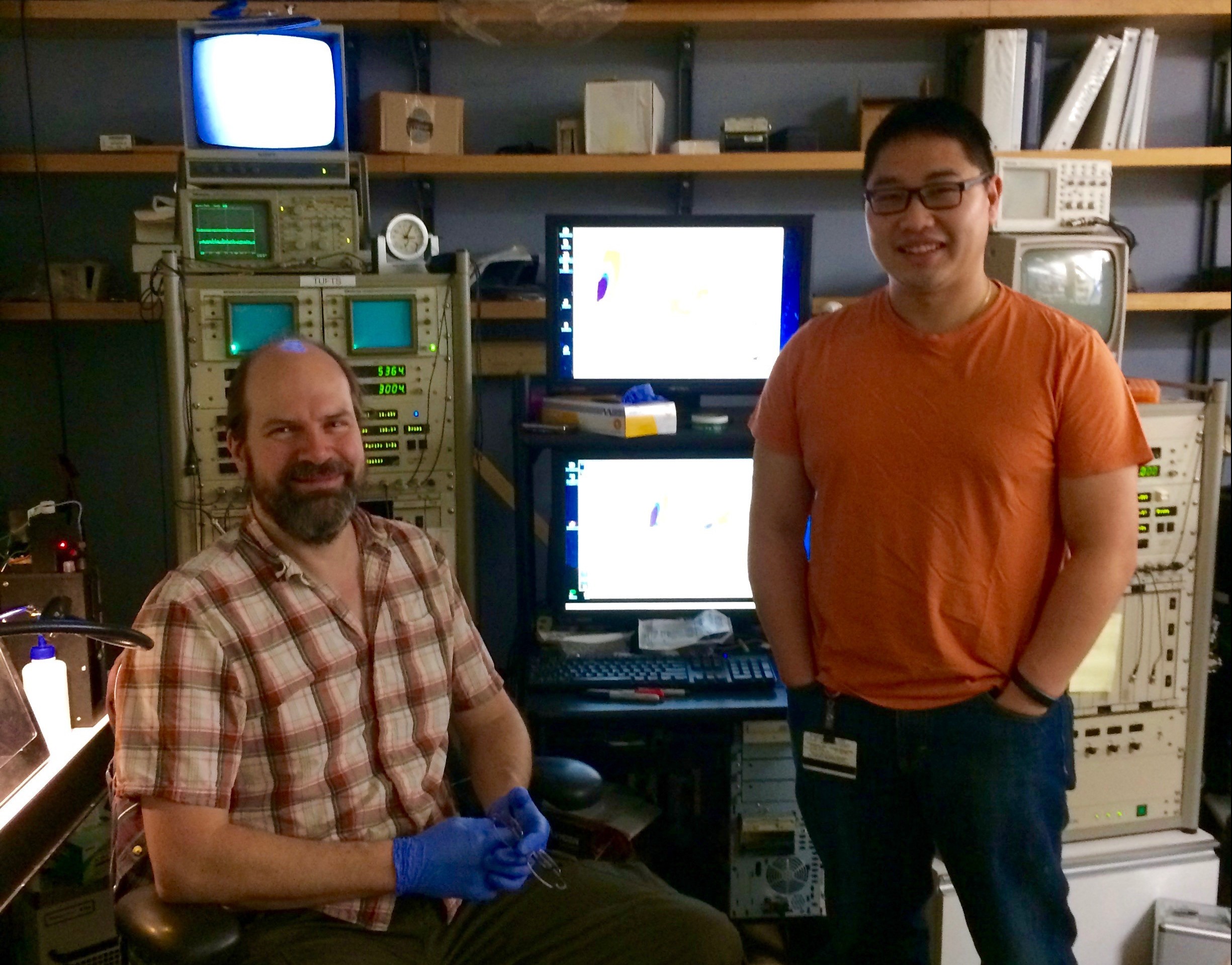
There are always plenty of questions to answer about FLOW. How fast is fast? Well the Analyzers can run approximately 3,000 cells per second. The high speed cell sorters. 30,000 cells per second! This can translate to over 100e6 per hour. How sensitive are the machines? We can detect one cell in 10e6 cells! How many markers can I use? The most common is 4 different colors at a time, but we could do up to 17. Be wary, however, just because we said you can. Doesn’t mean you should. Work smarter, not harder! I have 4 different populations: can I sort them all at once? Yes! In fact, we can do up to 6 simultaneous separate populations at once.
How can I do good flow cytometry? The key is sample prep! Yes, they seem like magical boxes, but the experiment is only as good as the components. Titer your antibodies. TEST them with a positive control. Bring a negative or untreated control as a baseline. Would you run a gel without the markers? Find the correct markers, and look for the greatest separation. Cells need to be in Single Cell format. It is highly recommended to filter/strain your samples because the pathway for the cells are 70-150um in size, a clump of cells can clog the machines and render them inoperable.
Come by, check out the machines, ask us questions…we hope you’ll be pleasantly surprised at the possibilities.
Tufts Laser Cytometry, Jaharis 5th floor.
Special points of interest:
- No Color Cloning
- Bulk Sorting
- Fluorescent work
- Cell Cycle
- Apoptosis
- Ca+ Flux
- Single Cell PCR
- Rare Event
- Bacteria
- CRISPR
- Stem Cells
- Neurons
- Transfections
- Infections
- Libraries


